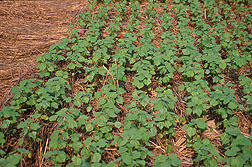In order to ensure adequate levels of biomass, growers should recognize the importance of cover crop establishment. Similar to establishment concerns for cash crops, growers should:
- Maintain soil fertility and pH levels at optimum levels;
- Purchase quality seed;
- Achieve good seed to soil contact.
Routine soil sampling for cash crops will help ensure cover crops do not suffer from general soil fertility and pH problems. Purchasing quality seed with high germination levels promotes rapid seed emergence and quicker ground coverage. Good stand establishment is associated with adequate seed to soil contact. A no-till drill is the best way to plant cover crops into existing surface residue to ensure good seed to soil contact; however, despite this one pass establishment method, it is slow. Other methods involve broadcasting, which typically also requires increasing seeding rates. Broadcasting also requires another trip across the field to incorporate the seed.
In addition to these general considerations, growers should also consider the following management aspects for cover crops to promote high levels of cover crop biomass.
Plant Early
Making time to plant a cover crop in the fall is a common complaint routinely expressed by growers interested in adopting cover crops. Field operations associated with cash crop harvest traditionally take precedence over establishing a cover crop. Unfortunately, delaying cover crop planting dates can limit subsequent biomass production and associated benefits of the cover crop.
Fertilize
Many soils across the South tend to be sandy and do not retain high levels of residual inorganic N. Although cereal cover crops are excellent scavengers of residual N (Dabney et al., 2001), residual N levels are generally not present at levels to enhance cover crop biomass production. Some exceptions may occur, if high N rates were applied to a summer crop during a dry growing season, but these situations are uncommon.
Nitrogen fertilizer can significantly improve cover crop biomass production as compared to no fertilizer and associated benefits of that biomass. Cereal cover crops will respond to high N rates, but costs associated with high N rates can be prohibitive. Research indicates 30 lb N/ac, applied in early fall or spring is sufficient to achieve adequate biomass levels.
Timing of cover crop termination is a key decision growers must make each year. Numerous factors affect this decision to ensure successful cash crop establishment (Balkcom et al., 2015). This termination decision initiates the residue management process.
Operating tillage or planting equipment in dry, brittle cover crop residue helps facilitate equipment performance in residue.
Numerous equipment modifications have been developed that allow for successful cash crop establishment in heavy residue.
Modifications and improvements include shank and coulter designs for tillage equipment and row cleaners and closing wheels for planters.
Successful residue management is also possible when operations are combined to save time, such as, rolling a cover crop with strip tillage or strip tillage and planting.
This product was developed with support from the Southern Sustainable Agriculture Research and Education (Southern SARE) program, which is funded by the U.S. Department of Agriculture—National Institute of Food and Agriculture (USDA-NIFA). Any opinions, findings, conclusions or recommendations expressed within do not necessarily reflect the view of the Southern SARE program or the U.S. Department of Agriculture. USDA is an equal opportunity provider and employer.
